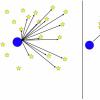Thank you for the answer Turnbuckle. Let me try and briefly respond.
Please see the parts from your messages that I bolded (especially what I underlined):
How many cycles you need with the original protocol will depend on your initial level of damage. If you look at Fig. 1 (A) of the second paper cited in the OP, you will see that cells cultured continuously with 5 mM NAM lost 20% of their mito mass in 24 hours, after which the loss rate much declined. This is a much higher NAM concentration than the protocol will create. How much mitochondrial mass is lost per cycle is speculative, but let's optimistically say it's 10%, and let's say you have 90% initial damage and that the PINK1/Parkin process is perfect, only getting rid of mutated mitochondria.
...
If you work this out on a spreadsheet, you will see that it takes 23 cycles to eliminate all mutated mitochondria.
Where do we get the 10% from? Absolutely totally pulled out of thin air. As someone deeply familiar with non-linear, complex systems, I have repeatedly observed that such systems have several unpredictable "kinks" and waves in the dose-response relationship graphs and these sorts of exercises, where we make estimates as you do, tend to be wildly inaccurate. I have operated in exactly this sort of fashion myself when dealing with complex systems and made exactly these sorts of "best effort" or "optimistic" or "pessimistic" assumptions and have simply walked away with the impression that these approaches tend to be far more often very wrong than to be even remotely right.
Just to demonstrate my argument with a totally hypothetical example: It could very well be that increasing the concentration of the "trigger" by 4.8 fold (a random number to demonstrate a principle) above baseline may result in 20% reduction in defective mitochondria, while increasing the same substance by 2.4 fold in the same tissue may eliminate almost no defective mitochondria at all.
The far bigger assumption is that as we repeat this over and over again, we will attain the same result despite dramatically declining number of defective mitochondria. Again, seems very unlikely. Based on what? based on nothing concrete; based only on my observations of biological systems.... just a personal opinion of someone who has no recognized degree or published work in the field. I only would like to state that biological systems almost always present roadblocks as you repeat the same intervention over and over. I would very much expect -again based on no concrete data whatsoever- that possibly the various defective mitochondria will exhibit varying degrees of resistance to elimination/clearance, making each round less effective at some point and then almost completely ineffective at a later stage at some point. To continue to be equally successful in removing them at each pass appears very likely.
I showed experimental results of a cyclic treatment in post 1739...
You did not. To attach the term "experimental results" to what you have presented just demonstrates a totally unwarranted degree of confidence in your casual, personal observations. My passion for biology comes from my involvement in athletics. I have been around very ambitious athletes for a very long time. People (referring to not you or anyone on this forum, but making a general statement) live in a fantasy world and are under the impression that simple interventions exist to boost endurance or other athletic outcomes in a short amount of time -some of such interventions being legal and some banned in international sports. The reality is that boosting endurance with any sort of intervention -except of course specific exercise regimens- is extremely hard. If only you guys saw how little benefit such famous doping substances as EPO or cortisol provide, you'd be shocked (strength output BTW is a little different and can be elevated relatively more easily in the short term -albeit the results will likely not be long-lasting).
The results that you keep posting in this as well as other threads are so outrageous that they are simply not credible in the least and erode almost all credibility. Increasing endurance measurably with just a few cycles of the above??? People commenting that you actually look younger after 2 weeks of something??? In another thread regarding the use of red light, you posting that with the use a very weak light source, immediately feeling a reduction in hunger and then seeing dramatically accelerated fat loss on top of that? These claims are so outrageous that they are simply impossible to take seriously, thus also casting an unfavorable light on the rest of the discussion.
You speak of assumptions, but you told user stephen_b that 15 cycles was "a very large number of cycles." What was your basis for that statement?
True, simply reading my previous comment, one can be left feeling that I too am making arbitrary assumptions about how quickly these interventions should or should not work. Let me rephrase my earlier question to stephen_b as follows. This will far better illustrate my position:
Stephen,
Throughout this thread, it appears that some people are seeing some kind of perceivable/observable results from these cycles after far fewer than 15 rounds; at least, that has been my impression thus far. If someone did the cycle 15 times, I would be inclined to think that the person has felt something along the way, thus continuing to stay motivated to carry on. Having read the user feedback on this thread, had I done 10 cycles without observing any benefit, I would perhaps have stopped the experiment as I would have concluded that "if this was going to work, it would have worked by now."
...................................................
With all that being said, you may then ask "well, then get the heck out of this thread; why are you still reading this?"
I am reading this, because you have an absolutely astounding degree of commitment to this cause. You dig out information and present it generously here. This much valuable information one would have to spend months, if not years to compile. The depth and breadth of information here just boggles the mind. It is merely some of the conclusions you draw that I have issues with.
If this is something that you don't mind answering in broad and vague terms, where does such dedication and attention to detail come from -as in what is your original profession / background? Because lemme tell ya, if I can serially produce a hundred Trunbuckles and put them to good use, I am sure we can land a spaceship on a planet at the far end of the milky way in a decade.

































 This topic is locked
This topic is locked






































